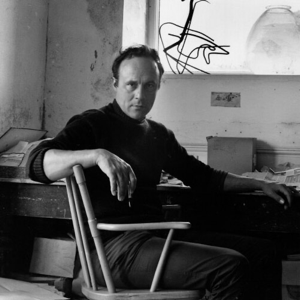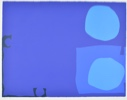British, (1920–1999)
Patrick Heron was born January 30, 1920. Heron was an abstract painter, writer, and designer who made noteworthy contributions to the development of abstract art.
And as we look at his life, you’ll see, it’s almost as if he was always determined to manifest a life in the arts. Heron loved his hometown St Ives in Cornwall and a lot of his work, especially during the early years, were directly inspired by scenes and images from the region. An artist and critic, Heron would become recognized as one of the leading painters of the St Ives School.
In 1933, Heron began to paint under the influence, you might say, of Paul Cézanne after visiting the National Gallery in London during a school trip. During World War II, only a teenager, Heron met many leading artists of the St Ives School. This endeared Heron to the European Abstract Expressionist movement and in 1943, at only 13 years old, Heron completed what would be considered his first mature painting, The Piano. During this time he was also designing silk scarves for his father’s company.
Impressed by an exhibition of work by the father of cubism, Georges Braque, at the Tate Gallery in London, Heron wrote his first essay on Braque in 1946. Immediately after this, he began to tour Paris, Provence, and Italy. At age 17, Heron exhibited his first series of abstract paintings in a solo exhibition at Redfern Gallery in London in 1947. Heron’s love for painting continued to grow, and in 1950 at age 20, he attended the Slade School of Art in London. He then taught at the Central School of Arts and Crafts in London between 1953 and 1956.
Heron married young to his only wife, Delia. They had two daughters, Katherine and Susanna who would go on to become artists and architects and professors in their own right. The two maintained a close and loving relationship with their father for all his life. He even collaborated at times with each of their husbands on various exhibits and tours.
Heron first met American Abstract Expressionists in London in 1956, during an exhibition at the Tate Gallery, and it was around this time that his work made the leap from abstract interpretations of his surroundings to completely non-objective color and shapes. That means no recognizable objects from the real world. He described his work as spontaneous, impulsive even. He followed the shapes and colors as they came to him in the moment. Far from premeditated, he said that any commentary on his work took him weeks to decipher, long after the piece was finished and only if he was forced to put words to it. He loved to play around with color and light to create feelings in his paintings. Throughout his lifetime Heron made use of numerous media including etching, lithography, gauche, and screenprinting.
His compositions from this time range from stripe paintings to color fields containing soft edged discs, squares, and other shapes. In his famous lecture “The Shape of Color” (1973), Heron argued that color and shape were inseparable from each other. This ambition defines much of Heron’s work.
Heron's silkscreen print titled January 1973: 8 was gifted to OJAC by Heron’s fellow artist and friend, Kelly Fearing. It’s considered an artist’s proof, a test or mockup on the way to the final work which now resides at the Tate Modern in London. Fearing met Patrick Heron in the 50’s while Heron was teaching in London and Fearing at the University of Texas in Austin. The two became fast friends and Fearing would go on to champion Heron’s work in the US, even bringing him to lecture for the university students in Austin. Heron lectured and wrote extensively on abstraction in the US and the UK.
In 1979 his beloved Delia died. This was a hard blow and it took him a few years to start painting again. Later in life, Heron would travel and lecture as a featured guest all over the world. He won numerous awards in multiple countries. Heron continued to paint until the day before he died in 1999 in Cornwall, England. His works can be seen in museums around the world.
------------------
Patrick Heron (b. 1920, Leeds, England; d. 1999, St Ives, England) was a British artist and critic recognised as one of the leading painters of the St Ives School. Through his art and writing, Heron made a large contribution to the dissemination of modernist ideas in post-war Britain. Within the St Ives School he was closely associated with Ben Nicholson. Heron’s early painting was inspired by Braque, Bonnard, and especially Matisse’s colour harmonies and ‘all-overness’ where no part of the canvas is more important than any other. In 1956, Heron moved to Zennor, Cornwall, and began making abstract work inspired by tachisme and Abstract Expressionism. Heron’s compositions from this time range from stripe paintings to colour fields containing soft edged discs, squares and other shapes. In his famous lecture ‘The Shape of Colour’ (1973), Heron argued that colour and shape were inseparable from each other. This ambition defines much of Heron’s work. In later life, Heron indulged in a lighter palette and looser brushstrokes, embracing rhythm and dissonance in playful, luminous compositions full of colour-shapes and colour-forms.
Heron studied at the Slade School of Fine Art, London, between 1937 and 1939. From 1945, Heron resumed painting and also wrote as an art critic for The New English Weekly and The New Statesman and Nation. The 1946 exhibition of Braque’s work at the Tate Gallery, London, profoundly influenced Heron; he would write a book on Braque in 1956. The Redfern Gallery, London, hosted Heron’s first solo exhibition in 1947; his first solo exhibition was held in New York at the Bertha Schaefer Gallery in 1960. In 1956, he returned to Cornwall where he lived and worked until his death in March 1999. From 1980 to 1987, he was a Trustee of the Tate Gallery, London. He received Honorary Doctorates from Exeter and Kent Universities, Winchester School of Art and the Royal College of Art, London, amongst others. Heron won the Grand Prize at the John Moores Prize Exhibition in Liverpool in 1959 and the silver medal at the São Paulo Art Biennial in 1965. He held retrospective exhibitions at the Whitechapel Art Gallery in 1972 and at the Barbican Art Gallery in 1985. He visited Australia in 1967, 1973, and 1989, exhibiting at the Bonython Gallery, Sydney. A major retrospective of Heron’s work was organised by the Tate Gallery, London in 1998.
Four Blues, Two Discs 1982.042
January 1973: 11 1982.031
January 1973: 5 1982.032
January 1973: 8 1982.041





